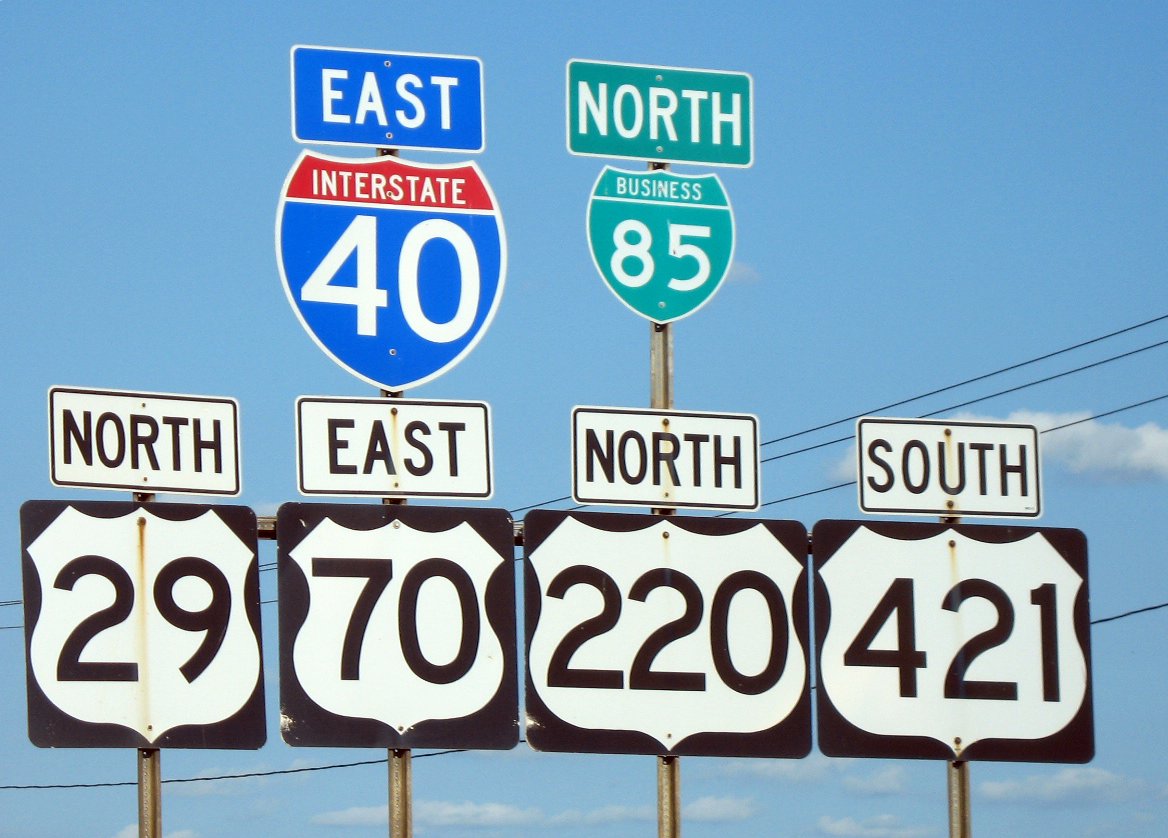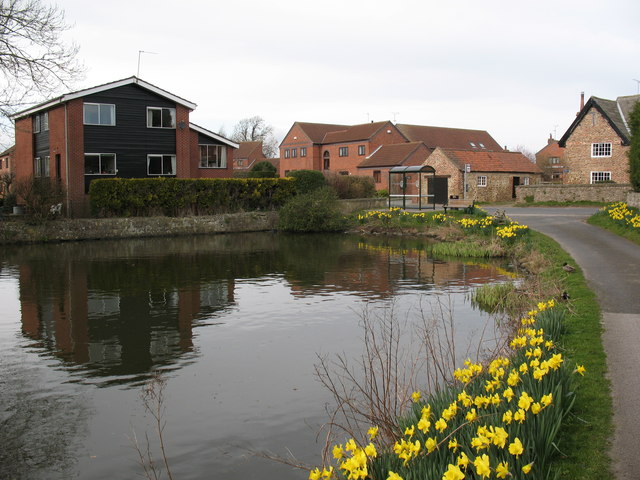|
A6055 Road
The A6055 is a stretch of road in North Yorkshire that runs from Knaresborough to Boroughbridge, with a break, then starts up again at Junction 50 of the A1(M) to run parallel with A1(M) acting as a Local Access Road (LAR) going between Junction 50 and 56 at Barton. Responsibility for the route rests with the Highways Agency, as it is designated as a primary route associated with the A1(M) upgrade. Route It runs in a North-northeast direction from the A59 at Bond End in Knaresborough where it is called Boroughbridge Road, through the Stockwells Estate. It exits Knaresborough just past Greengate Lane where it turns directly north, before once again resuming a northeasterly direction at a sharp bend on the junction with Farnham Lane. It passes the Knaresborough Golf Club, before going through Ferrensby Lodge, and taking another Northerly turn before reaching Ferrensby itself. Beyond Ferrensby the road is called Harrogate Road, and it continues in a more or less exact northeaste ... [...More Info...] [...Related Items...] OR: [Wikipedia] [Google] [Baidu] |
RAF Leeming
Royal Air Force Leeming or RAF Leeming is a Royal Air Force (RAF) station located near Leeming, North Yorkshire, England. It was opened in 1940 and was jointly used by the RAF and the Royal Canadian Air Force (RCAF). Between 1950 and 1991, it operated mostly as a training base with Quick Reaction Force (QRF) Panavia Tornado F3 fighters based there in the latter stages of the Cold War and into the early 21st century. Since 2006, it has become the home of the deployable RAF communications cadre ( No. 90 Signals Unit RAF) and the home of No. 135 Expeditionary Air Wing. History The area at the extreme western edge of the base was used in the 1930s by local flying enthusiasts. It took the name of ''Londonderry Aerodrome'' as it was closest to the hamlet of Londonderry in North Yorkshire. In the late 1930s, the Royal Air Force bought up the aerodrome and most of the surrounding land to convert it into an RAF airfield, which became known as Royal Air Force Leeming. Part of the buildu ... [...More Info...] [...Related Items...] OR: [Wikipedia] [Google] [Baidu] |
A59 Road
The A59 is a major road in England which is around long and runs from Wallasey, Merseyside to York, North Yorkshire. The alignment formed part of the Trunk Roads Act 1936, being then designated as the A59. It is a key route connecting Merseyside at the M53 motorway to Yorkshire, passing through three counties and connecting to various major motorways. The road is a combination of historical routes combined with contemporary roads and a mixture of dual and single carriageway. Sections of the A59 in Yorkshire closely follow the routes of Roman roads, some dating back to the Middle Ages as salt roads, whilst much of the A59 in Merseyside follows Victorian routes which are largely unchanged to the present day. Numerous bypasses have been constructed throughout the 20th century, one of the earliest being the Maghull bypass in the early 1930s, particularly where traffic through towns was congested. Portions of the route through Lancashire were proposed to be upgraded to motorway sta ... [...More Info...] [...Related Items...] OR: [Wikipedia] [Google] [Baidu] |
River Swale
The River Swale in Yorkshire, England, is a major tributary of the River Ure, which becomes the River Ouse, that empties into the North Sea via the Humber Estuary. The river gives its name to Swaledale, the valley through which it flows. The river and its valley are home to many types of flora and fauna typical to the Yorkshire Dales. Like similar rivers in the region, the river carves through several types of rock and has features typical of both river and glacial erosion. The River Swale has been a contributory factor in the settlements that have been recorded throughout its history. It has provided water to aid in the raising of crops and livestock, but also in the various mining activities that have occurred since Roman times and before. The river is said to be the fastest flowing in England and its levels have been known to rise in 20 minutes. Annual rainfall figures average 1800 mm p.a. in the headwaters and 1300 mm p.a. in the lower waters over a drop of 14 ... [...More Info...] [...Related Items...] OR: [Wikipedia] [Google] [Baidu] |
A6055 And A6136
A6, A 6 or A-6 can refer to: Arts and entertainment *A6, a mutated flu virus in the short story "Night Surf" by Stephen King *A-6, a renamed version of the US Security Group in the 1997 comic book movie ''Spawn'' Electronics and software * A6 record, a type of DNS record *Apple A6, a System-on-a-chip ARM processor * Hanlin eReader A6, an ebook reader * Samsung Galaxy A6, a smartphone by Samsung Military *A6, the designation for air force headquarters staff concerned with signals, communications, or information technology **In the United Kingdom, the A6 Air CIS (Computers & Information Systems) branch, also known as JFACHQ, UK Joint Force Air Component Headquarters *A 6, a Swedish artillery regiment *Grumman A-6 Intruder, a twin-engine, mid-wing all-weather US Navy medium attack aircraft manufactured by Grumman, in service from 1962 to 1997 Science and technology Biology *British NVC community A6 (Ceratophyllum submersum community), a British Isles plants community * Noradrenerg ... [...More Info...] [...Related Items...] OR: [Wikipedia] [Google] [Baidu] |
Primary Road
The United Kingdom has a network of roads, of varied quality and capacity, totalling about . Road distances are shown in miles or yards and UK speed limits are indicated in miles per hour (mph) or by the use of the national speed limit (NSL) symbol. Some vehicle categories have various lower maximum limits enforced by speed limiters. A unified numbering system is in place for Great Britain, whilst in Northern Ireland, there is no available explanation for the allocation of road numbers. The earliest specifically engineered roads were built during the British Iron Age. The road network was expanded during the Roman occupation. Some of these roads still remain to this day. New roads were added in the Middle Ages and from the 17th century onwards. Whilst control has been transferred between local and central bodies, current management and development of the road network is shared between local authorities, the devolved administrations of Scotland, Wales and Northern Ireland, a ... [...More Info...] [...Related Items...] OR: [Wikipedia] [Google] [Baidu] |
Concurrency (road)
A concurrency in a road network is an instance of one physical roadway bearing two or more different route numbers. When two roadways share the same right-of-way, it is sometimes called a common section or commons. Other terminology for a concurrency includes overlap, coincidence, duplex (two concurrent routes), triplex (three concurrent routes), multiplex (any number of concurrent routes), dual routing or triple routing. Concurrent numbering can become very common in jurisdictions that allow it. Where multiple routes must pass between a single mountain crossing or over a bridge, or through a major city, it is often economically and practically advantageous for them all to be accommodated on a single physical roadway. In some jurisdictions, however, concurrent numbering is avoided by posting only one route number on highway signs; these routes disappear at the start of the concurrency and reappear when it ends. However, any route that becomes unsigned in the middle of the concurren ... [...More Info...] [...Related Items...] OR: [Wikipedia] [Google] [Baidu] |
A1 Road (Great Britain)
The A1 is the longest numbered road in the UK, at . It connects Greater London, London, the capital of England, with Edinburgh, the capital of Scotland. It passes through or near North London, Hatfield, Hertfordshire, Hatfield, Welwyn Garden City, Stevenage, Baldock, Letchworth, Letchworth Garden City, Biggleswade, St Neots, Huntingdon, Peterborough, Stamford, Lincolnshire, Stamford, Grantham, Newark-on-Trent, Retford, Doncaster, York, Pontefract, Wetherby, Ripon, Darlington, Durham, England, Durham, Sunderland, Tyne and Wear, Sunderland, Gateshead, Newcastle upon Tyne, Morpeth, Northumberland, Morpeth, Alnwick and Berwick-upon-Tweed. It was designated by the Department for Transport, Ministry of Transport in 1921, and for much of its route it followed various branches of the historic Great North Road (Great Britain), Great North Road, the main deviation being between Boroughbridge and Darlington. The course of the A1 has changed where towns or villages have been bypass (road), ... [...More Info...] [...Related Items...] OR: [Wikipedia] [Google] [Baidu] |
Staveley, North Yorkshire
Staveley is a village and civil parish in the Harrogate district of North Yorkshire, England. It is situated north of Knaresborough and near the A1(M) motorway. In the 2001 census, the village had a population of 444, which had risen to 450 by the time of the 2011 census. In 2015, North Yorkshire County Council estimated the population to have dropped to 440. History The village is mentioned in the Domesday Book as belonging to Gospatric. The name ''Staveley'' is Anglo-Saxon and means ''the clearing where the staves were brought from''. The racehorse Staveley, winner of the 1805 St Leger Stakes, was born at nearby Boroughbridge. The village used to have a railway station on the now disused Pilmoor, Boroughbridge and Knaresborough Railway. When it opened, it was called ''Staveley'', but from 1881 its name was taken from nearby Copgrove village to avoid confusion with Staveley in Derbyshire. The grade II listed, Church of All Saints, was built in 1864 and holds services tw ... [...More Info...] [...Related Items...] OR: [Wikipedia] [Google] [Baidu] |
Ferrensby Lodge
Ferrensby is a village and civil parish in the Harrogate district of North Yorkshire, England. The population of the civil parish at the 2011 census was 187. It is about north-east of Knaresborough and near the A1(M) motorway. Nearby attractions include a balloon centre and a maze. The origin of the place-name is from Old Norse and probably means "farmstead or village of the man from the Faroe Islands", and appears as ''Feresbi'' in the Domesday Book of 1086. The village has a public house called ''The General Tarleton'' which was named after Banastre Tarleton Sir Banastre Tarleton, 1st Baronet, GCB (21 August 175415 January 1833) was a British general and politician. He is best known as the lieutenant colonel leading the British Legion at the end of the American Revolution. He later served in Portu ..., a British general who fought on the loyalist side during the American War of Independence. References External links Villages in North Yorkshire Civil par ... [...More Info...] [...Related Items...] OR: [Wikipedia] [Google] [Baidu] |
Ordinal Direction
The four cardinal directions, or cardinal points, are the four main compass directions: north, east, south, and west, commonly denoted by their initials N, E, S, and W respectively. Relative to north, the directions east, south, and west are at 90 degree intervals in the clockwise direction. The ordinal directions (also called the intercardinal directions) are northeast (NE), southeast (SE), southwest (SW), and northwest (NW). The intermediate direction of every set of intercardinal and cardinal direction is called a secondary intercardinal direction. These eight shortest points in the compass rose shown to the right are: # West-northwest (WNW) # North-northwest (NNW) # North-northeast (NNE) # East-northeast (ENE) # East-southeast (ESE) # South-southeast (SSE) # South-southwest (SSW) # West-southwest (WSW) Points between the cardinal directions form the points of the compass. Arbitrary horizontal directions may be indicated by their azimuth angle value. Determination Addi ... [...More Info...] [...Related Items...] OR: [Wikipedia] [Google] [Baidu] |





